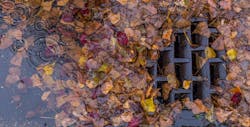1. Capturing Sediment on the Go
Sewer covers, nets and barriers are meant to keep sewers flowing free of potentially polluting sediment and chemicals. But traditional versions of these solutions have problems: traffic impediments. Slow flows. Clogs. Back-ups cause dangerous street flooding. Materials that can’t be reused run up costs.
If it rains too much, if the material is driven over, or if it moves, traditional solutions are prone to failure. Then untreated storm water, sediment, trash and debris threaten underground infrastructure systems.
Some inlet protection devices end up as debris themselves. Contractors are paid to install them but not remove them.
Flo-Water created its inlet protection and dewatering devices to address all these issues. Filtering devices have smaller footprints than other devices for improved traffic flow and decreased risk of damage from vehicles. A small footprint means they are less likely to be knocked out of the way. They stay put and protect underground infrastructure. These products prevent pooling with increased flow rates and effective overflow engineering.
Flo-water’s tube dewatering bags are smaller than traditional dewatering units, and they are built to speed up dewatering and capture more sediment. Both the dewatering bags and the reusable inlet protection devices (designed to stay on site for post construction) achieve cleaner water with less material waste.
These products can flow up to 2.5 times faster than traditional solutions, while capturing 15% more sediment. Flo-Water’s president, Corydon Coppola, realized erosion control had come a long way, but sediment control had some catching up to do.
“I really grew my passion for water quality,” Coppola says of his years in the erosion and sediment control fields. “If we get true water quality in play, we can take care of our people and our environment. And improving water quality doesn’t always mean doing something harder.”
2. Sequestering Emerging Contaminants
Looking deeper into pollution from runoff, augmenting soil around flood basins with natural filtration media can address potential chemical or biological threats to source water.
A biocarbon media made from rice hulls sequesters metallurgical and biological toxins. Glanris, a company founded in the U.S. southeast (aka “the rice belt”) hit upon a method of pyrolyzing rice hulls to create a clean, effective alternative to traditional biochar and ion exchange resin beads.
Glanris’ Biocarbon media is an International Biochar Initiative-certified biochar filtration media. But unlike traditional biochar, Glanris’ biocarbon filters both organic contaminants and dissolved metals, including copper, nickel and chromium. Once removed by the filtration media, dissolved metals can be recovered with mild acid rinsing.
Another metals-removal filtration media is a resin microplastic. Microplastics have become a pollutant that persists for generations. By contrast, Glanris’ filtration media uses no toxic plastics and protects the environment by sequestering carbon.
Glanris’ Biocarbon media provides additional advantages: it functions in a wider pH range than typical biochar, does not foul in the presence of oils or grease, is effective in a single pass, and can cost only 1/10th of the price of ion exchange resin beads.
Additional cost savings come from the product’s light weight. This saves money on shipping and per-pound disposal. The granular media ships at 8 pounds per cubic foot. The powdered media weighs 22 to 28 pounds per cubic foot. Typical activated carbon weighs over 30 pounds per cubic foot.
“Pollution and industrial runoff are leaching into our water supply, making them undrinkable,” said Glanris CEO Bryan Eagle. “There is now a sustainable, more affordable way to filter out contaminants. Water scarcity and water security are driving demand for new technologies, like Glanris’ water filtration media.”
In the wastewater world, biochar is known to increase sludge dewaterability. With the added benefit of removing dissolved metals, Glanris’ Biocarbon media would enhance dewaterability and water quality in applications beyond wastewater, such as catchment soils, rain barriers and permeable pavement.
“We need more sustainable approaches to dealing with water filtration around extreme weather events,” said Eagle. “Glanris’ Biocarbon media can be implemented for environmental remediation, enhancing the filtration capabilities of permeable pavement and barrier technologies. It can also filter discharge water, preventing pollution of our freshwater resources.”
3. Maintaining a Sustainable Landscape
Vegetation can reduce flooding from storm water, but not all plants are created equally. Lawns often underperform. They can, themselves, become waterlogged or flooded and have runoff.
Pearl’s Premium Ultra Low Maintenance Lawn Seed broke that mold. A patented seed blend that scores six LEED (Leadership in Energy and Environmental Design) credits under the US Green Building Council, Pearl’s Premium becomes, in effect, a 4-6-foot-deep sponge and filter. It holds water that would overwhelm the typical lawn.
Jackson Madnick, creator and owner of Pearl’s Premium shepherded this proprietary blend through over 10,000 experiments over an eight-year period with assistance from a team of PhD turf scientists to find the winning combination. This U.S. Patented mixture along with 12 years of slight but important improvements, is now in its seven generation.
Named in honor of Madnick’s environmentalist mother, Pearl’s Premium now grows in half a million sites across all 50 states and all climates of the world. It is the only grass permitted on Columbia University’s ultra-eco-conscious “Campus of the Future.” Pearl’s Premium has deep roots and extremely slow growth. Typical lawn roots grow only 3 to 8 inches deep.
Pearl’s Premium roots extend 4 to 6 feet. Deep roots allows Pearl’s Premium lawn to quickly soak up 4 inches of water. A normal lawn may only quickly soak up an inch, depending on soil type.
“By holding more water in soil, pollution from runoff is decreased and extreme demand on sewer systems is relieved during rainy periods,” Madnick said.
In one recent case study, Pearl’s Premium outperformed a rain garden by a fraction of the cost. A northeast residential customer lived at the low point of her neighborhood. When it rained, water poured in from neighbors’ lawns, flooding her yard. She spent $2,000 for a 200 square-foot rain garden. After installation, she was dismayed to find that it did not have enough capacity and she still experienced floods and soggy lawn.
When she spread $200 worth of Pearl’s Premium lawn seed over her existing lawn, surrounding the water garden, within a month she no longer had rain problems. Rainfall poured in from surrounding lawns as usual, but when it got 10-20 feet into her yard, it “sank into the soil and disappeared” instead of flooding.
As in this case, the product can be spread over existing grass because it outcompetes prior plantings and most weeds. Madnick notes the blend produces a dark emerald green, “barefoot soft” lawn that only needs to be mowed about once a month, rather than weekly mowing. This lawn seed requires no chemical fertilizer to stay green and outcompetes most weeds and reduces watering costs by up to 80% after getting established.
The seventh-generation version of the blend also sequesters 8 times the carbon of ordinary shallow root grass to help lessen climate change. It also includes biochar, which encourages maximum root growth and increases the planting’s filtration function.
Take Away
There is no one-size fits all solution but combining these three strategies may give you a better sense of calm before the next storm. Unsure what your risk is? Check out the US EPA National Stormwater Calculator: https://www.epa.gov/water-research/national-stormwater-calculator.






